Climbing rose "Sympathy": description of the variety, planting and care features

Climbing roses often become the main decoration of the garden. They can be an element of a garden composition, participate in group plantings, be used as a hedge, however, it is not so easy to grow such a beautiful bush. For this, amateurs are encouraged to start growing with the simplest variety - "Sympathy".
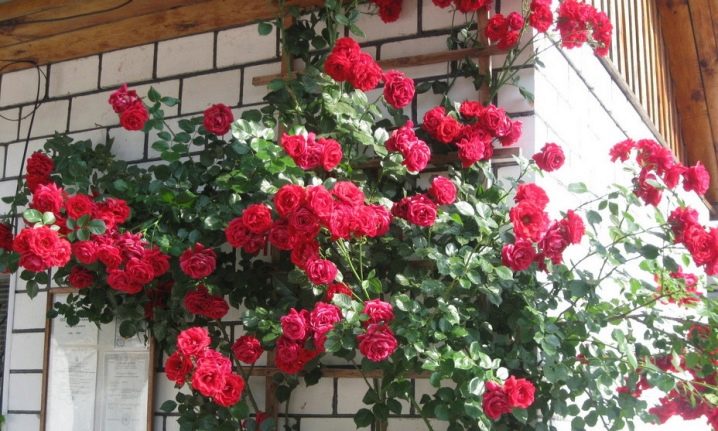
Description
The climbing rose itself is a flowering garden plant that is the result of crossing rose hips and some varieties of roses with long shoots. "Sympathy" is considered one of the most popular varieties, as it is characterized by unpretentious care and aesthetic appearance.
Bred in the second half of the 20th century, it is a large-flowered re-flowering plant.
An adult bush grows up to 5 meters, its diameter can reach 2 meters. Such a voluminous bush can be used to decorate a fence, arch, wall. Therefore, when planting, it is necessary to prepare a stable and strong support. The flowers of this variety have a rich scarlet color, their structure can be compared with terry, the diameter of one bud reaches 10 cm. Their aroma is very pleasant. Flowers grow quite densely, each has 20-25 petals.


Impressive fluffy greenery and massive flowers look very beautiful on the exterior of the garden area. Like all other climbing roses, "Sympathy" grows rather quickly and for a long time. The beginning of flowering occurs in early June, the bush fades with the arrival of a cold snap. The peak of flowering falls on the first wave, with repeated flowering, the bush does not bloom so abundantly.
The advantages of the variety include resistance to ultraviolet rays - the petals do not fade in the sun. After rain, there are no marks or streaks on the buds. The culture tolerates frost or a sharp change in temperature regime quite firmly. Not particularly susceptible to diseases and pests.


Landing
The cultivation of the presented variety is possible not only in warm climates, but also in the middle lane. True, in the second case, the plant must be insulated for the winter. When choosing a site, it is recommended to choose a place that is well lit by the sun. Under such conditions, the first flowers may appear as early as next year. If roses are grown to decorate an object, then it is necessary to plant them at a distance of 50 cm from the desired place.
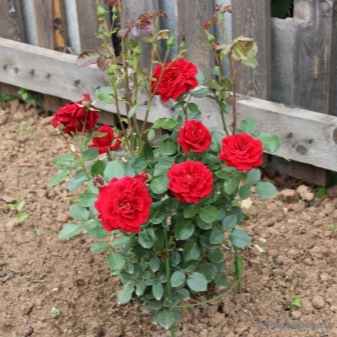
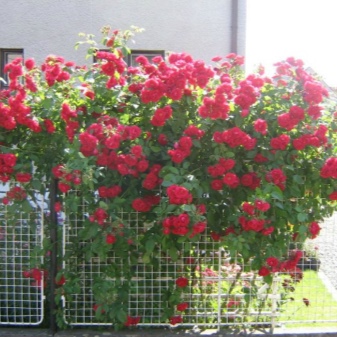
It is best to start planting in the fall, then the first shoots will begin to develop even before frost. In the case of spring planting, it will take much longer to wait for the first flowers, besides, a specimen planted in spring requires more serious care. When planting, use the following guidelines.
- Soak the planting material for one day.
- Divide the shoots and roots into two buds.
- Dig a hole 50 cm in diameter.
- Fill the prepared hole with fertilizer. To do this, you can use manure, superphosphate, lime, tree resin.
- Bury the roots in the ground at a level of at least 10 cm.
- If several specimens are planted, then observe a distance of at least a meter between the shoots.
- Upon completion of planting, the part of the bush that remains 20 cm above the ground should be eliminated.
This procedure will ensure the active growth of the culture.
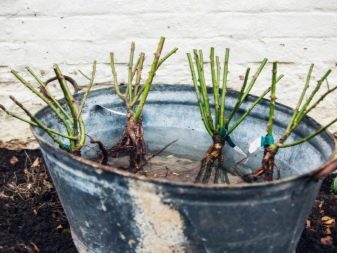



If a rose is grown using cuttings from a previous plant, then you need to follow these steps.
- Start multiplying flowers in mid-summer.For this, both summer and winter cuttings cut from healthy plants immediately after flowering are suitable.
- Each stalk must have at least four buds. All leaves are removed from below.
- Prepare a growing container. It can be a box or a pot.
- Fill the container with a substrate, for example, sand and earth in a centimeter layer.
- Plant the cuttings in the resulting soil and cover them with a glass jar.
- Remove to a shaded place, water as the soil dries.
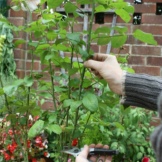
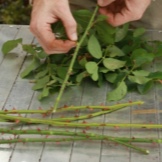

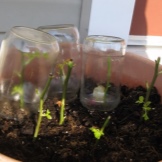
Care
As mentioned above, caring for the variety is not particularly difficult, however, some growing rules should still be known.
Watering and loosening
The culture belongs to the species that easily tolerate drought, so this rose does not need frequent and abundant watering. It is recommended to pour 1-2 buckets of water under the bush every 7 days. Gardeners advise organizing a near-trunk circle with a sandy fence on the site so that water does not spread over the territory. It is better to water the plant with settled water.
To prevent the soil from hardening after the watering procedure, it should be loosened and mulched. Peat, sawdust, tree bark are suitable for mulch. These materials will help maintain a moist atmosphere around the bush and prevent weeds from germinating. If you mulch the trunk circle, then you can water the culture even less often.
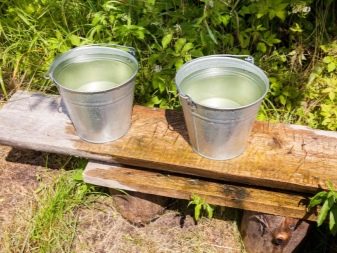

Top dressing and fertilization
If, during planting, a large amount of mineral fertilizers and organic matter is laid in the ground, then for the first couple of years the bush can not be fed, it will have enough useful elements. They begin to feed the plant in the third year. The crop reacts well to manure or wood ash.
In the fall, it is recommended to make top dressing, which contains potassium. Both general-purpose store-bought fertilizers designed for flowering crops and ordinary wood ash are suitable. You should also feed the bush with phosphorus, sodium, calcium. All these elements will allow the rose to survive the winter. The most favorable time for feeding is spring.
And when the bush begins to bloom, you should not apply fertilizer.

Garter and trim
A garter is a must for any climbing plant. Any hedge, fence, wall, arch, trellis is suitable as a support. You can design the device yourself, for example, in the form of a lattice. A support is installed 50 cm from the shoot. It is recommended to systematically inspect the structure and make sure that it does not fall under the weight of the overgrown branches and does not harm the bush.
Experts do not recommend tying all the whips up, otherwise all the flowers will end up on top. Some of the main shoots need to be tied up horizontally, giving the bush a more aesthetic shape. For a garter, gardeners are advised to use plastic twine. It is good because it does not damage the bush.

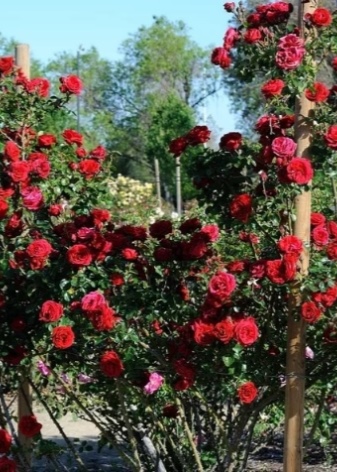
Pruning is required in spring and autumn. In the spring, dry and diseased branches should be eliminated, and the ends of the branches should be removed to a strong outer bud. In the fall, you need to remove faded buds and thin out the stems. After the fourth year, the bush needs a radical pruning, since by the fifth year the flowering of the main shoots of this variety weakens.
Grafted seedlings in the first two years do not develop the root system well, but if a rosehip was used as a stock, then the opposite effect is observed - the roots grow strongly, and therefore the shoots also need to be periodically eliminated.
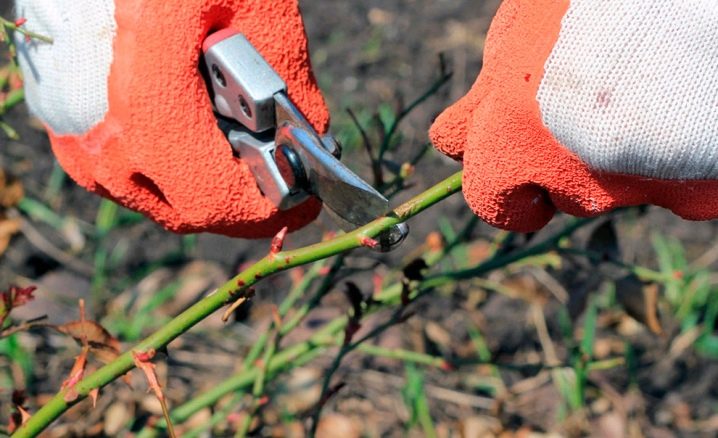
Preparing for winter
If a rose of this variety is planted in a cold region, then it needs to be covered for the winter. Before that, in the fall, the old branches are cut off, the shrub is thinned out. Already in the first half of autumn, preparing the plant for winter, they stop watering it. Fallen leaves are collected under the bush and treated with a disinfectant. Next, you need to carefully remove the branches from the support, lower them down to the ground and fix them. At the same time, it is better not to lay the plant on the ground. Then the rose is covered with foil or spruce branches.All manipulations are carried out in dry weather.
You can cover the bush without removing it from the support. To do this, spruce branches are installed around the plant by means of twine, and from above it is wrapped in agrofibre. Try not to lean the covering material against the bushes too much so that it does not interfere with air circulation. The film is removed after a thaw.
The trunk circle also needs protection, you can fill it with a dense layer of peat with earth.

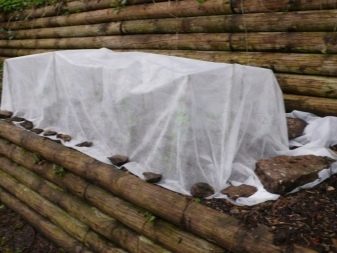
Diseases and pests
This variety is quite resistant to the formation of diseases and pest attacks, but if these problems cannot be avoided, then use the following recommendations.
- If the plant is attacked by aphids, then it can be defeated with soapy water. If spraying with the composition did not help, then an insecticidal preparation is used.
- If a gray tint is noticeable on the leaves, they dry and wither, and a cobweb is observed on the underside, then the bush has become a victim of a spider mite. The situation will be saved by spraying with an infusion of wormwood, yarrow or tobacco. Of the special preparations, gardeners recommend using Fitoverm.
- To protect the culture from the attack of insects, you can plant marigolds nearby, their smell scares off pests. As a preventive measure, you can spray the bush with Bordeaux liquid in the spring and autumn.
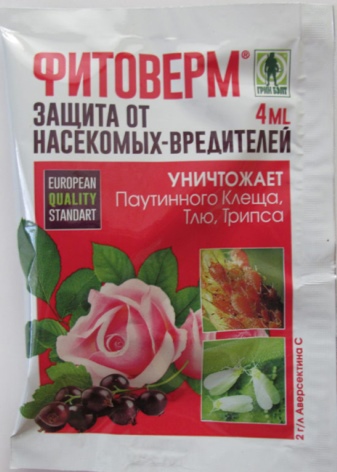

- If, with the arrival of spring, brown spots are noticed on the leaves, which eventually darken and form a ring around the shoot, then it can be assumed that the plant has become infected with the fungal disease coniotirium. Until the disease has destroyed the bush, it is necessary to cut off the damaged shoots along with the healthy part and burn. To prevent this disease, do not apply fertilizing containing nitrogen in the fall.
- A whitish bloom, gradually darkening, indicates the formation of another disease - powdery mildew. It is necessary to eliminate the infected branches, and treat the bush with a solution of copper (2%) or iron (3%) vitriol. As a preventive measure, spraying with soda ash and soap is suitable.


Reviews
Experienced agronomists, as well as novice gardeners, speak very well of the Sympathy variety. They like beautiful and lush flowers, very pleasantly fragrant. Such rich scarlet roses are noticeable from afar. It is noted that the plant blooms for a long time, and also does not need to select a special place for growing. For example, a bush grows in conditions of frequent fog and with a close location of groundwater. If the culture is frozen in a harsh climate, then it can be easily rehabilitated with the help of a garden varnish and slices of the affected areas.
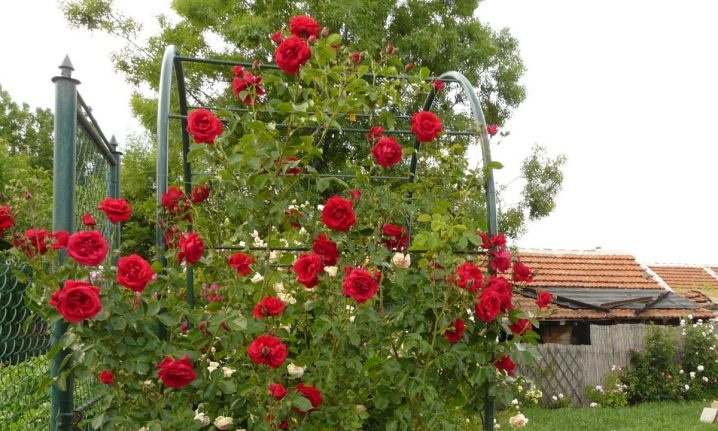
For more information about the climbing rose "Sympathy", see the next video.

































































































The comment was sent successfully.